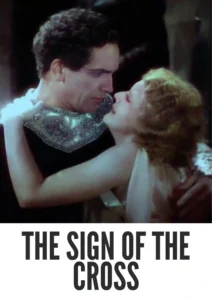Video Sources 0 Views

Synopsis
Ancient Rome Comes Alive: The Sign of the Cross (1932) in Vivid Color

Step back into the grandeur and drama of ancient Rome with The Sign of the Cross, Cecil B. DeMille’s 1932 epic, now beautifully colorized for a breathtaking viewing experience. This film delivers a powerful blend of historical drama, romance, and religious fervor, set against the backdrop of Nero’s reign. Perfect for classic film enthusiasts and those captivated by historical sagas, this HD download brings a visually stunning and emotionally resonant piece of cinematic history to your screen.
The Sign of the Cross Storyline: Love, Faith, and Intrigue in Nero’s Rome
The Sign of the Cross unfolds during the reign of Emperor Nero, a time of decadence and persecution of Christians. The story centers on Marcus Superbus (Fredric March), a Roman prefect, who falls in love with Mercia (Elissa Landi), a devout Christian woman. Torn between his loyalty to Rome and his growing affection for Mercia, Marcus becomes increasingly conflicted as Nero’s persecution intensifies.As Nero’s cruelty escalates, Marcus must choose between his allegiance to the empire and his love for Mercia. The film portrays the struggles of the early Christians, their unwavering faith, and the dramatic events that unfold in the Roman arena. Featuring lavish sets, elaborate costumes, and intense emotional performances, The Sign of the Cross is a sweeping epic that explores themes of love, faith, and sacrifice in the face of tyranny. Ultimately, it is a visually spectacular and emotionally compelling journey into a pivotal era of history.
Movie Cast
The film features a stellar cast of actors who bring this historical drama to life:
- Fredric March as Marcus Superbus
- Elissa Landi as Mercia
- Charles Laughton as Nero
- Claudette Colbert as Poppaea
- Vivian Tobin as Stefania
Movie Genre
The Sign of the Cross falls into the genre of epic historical drama, with elements of romance, religious themes, and spectacle that are characteristic of Cecil B. DeMille’s grand filmmaking style. Its sweeping scope and dramatic narrative make it a captivating and immersive film.
Historical Context: DeMille’s Epic Vision of Ancient Rome
Released in 1932, The Sign of the Cross represents Cecil B. DeMille’s ambitious vision of ancient Rome, showcasing his talent for creating visually stunning and emotionally resonant historical dramas. The film was produced during a period when Hollywood was embracing large-scale productions and elaborate set designs. While The Sign of the Cross is known for its historical inaccuracies and sensationalized elements, it offers valuable insights into the cultural and religious dynamics of the time and remains a significant example of early Hollywood epics.
Colorization Details
This colorized version of The Sign of the Cross has been meticulously restored using modern digital techniques, enhancing the visual appeal while preserving the film’s original atmosphere of grandeur and drama. The colorization process involved carefully analyzing the grayscale tones of the original black and white footage and assigning appropriate colors to each scene. While the specific software used remains proprietary, the techniques employed included advanced algorithms for color palette selection and image enhancement. This painstaking process brings new life to the characters and settings, making the story even more engaging for modern audiences. While some may debate the merits of colorizing classic films, it introduces these films to a broader audience, ensuring their legacy for future generations.
Technical Details
- Director: Cecil B. DeMille
- Screenplay: Waldemar Young, Sidney Buchman
- Based on: the play by Wilson Barrett
- Cinematography: Karl Struss
- Edited by: Anne Bauchens
- Production Company: Paramount Pictures
- Distributed by: Paramount Pictures
- Runtime: 125 minutes
Technical Specifications
- Download Format: MP4
- Resolution: HD (1080p)
- Compatibility: Compatible with most devices, including smartphones, tablets, computers, and smart TVs.
Reviews and Critical Reception
The Sign of the Cross (1932) is recognized as a significant work in Cecil B. DeMille’s career, demonstrating his skill in creating large-scale historical epics. While it has faced criticism for its historical inaccuracies and melodramatic elements, it remains a compelling example of early Hollywood spectacle and a valuable piece for film enthusiasts. As a visually impressive and emotionally charged film, The Sign of the Cross offers a unique perspective on ancient Rome and the early days of Christianity.
FAQs
- Q: What is The Sign of the Cross about?
- A: The Sign of the Cross is a historical drama about a Roman prefect who falls in love with a Christian woman during the reign of Emperor Nero.
- Q: Is The Sign of the Cross (1932) a well-known Cecil B. DeMille film?
- A: The Sign of the Cross is one of DeMille’s earlier and notable works, known for its grand scale and dramatic storytelling.
- Q: Is this version of The Sign of the Cross colorized?
- A: Yes, this version has been professionally colorized to enhance the viewing experience.
- Q: What makes The Sign of the Cross interesting for classic film fans?
- A: The Sign of the Cross offers valuable insights into Cecil B. DeMille’s early career, showcasing his talent for creating epic historical dramas.
- Q: What is the download format?
- A: The download format is MP4, which is compatible with most devices.
- Q: What resolution is the download?
- A: The resolution is HD (1080p), providing a high-quality viewing experience.
Download Now in HD!
Watch The Sign of the Cross Today!















